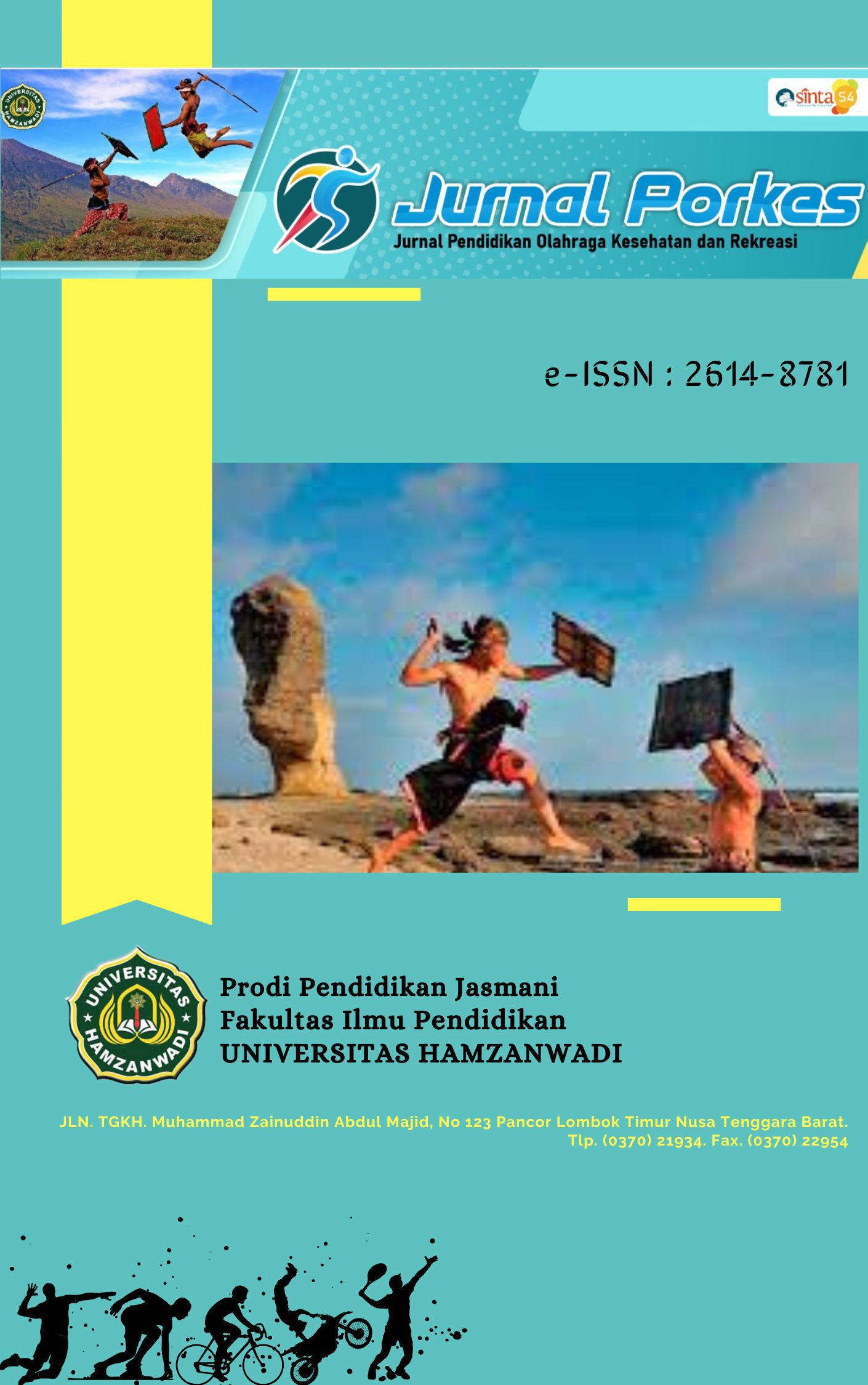Strategi Pemberdayaan Ekonomi melalui Festival Budaya Olahraga Tradisional di Kalimantan Tengah. Literatur Review
DOI:
https://doi.org/10.29408/porkes.v8i2.31386Keywords:
Cultural festival; traditional sports; economic empowerment; central kalimantanAbstract
This study aims to analyze the strategy of community economic empowerment through the Traditional Sports Culture Festival in Central Kalimantan. The method employed in this study is a literature review, by examining various scientific articles, official reports, and academic publications related to cultural festivals, traditional sports, and the creative economy published between 2000 and 2024. The results of the study showed that this festival succeeded in increasing the income of micro business actors (culinary and local crafts) during the event, as well as creating job opportunities for parking and transportation officers. The main strategies that support this success include: (1) integration of local culture in economic activities, (2) collaboration between stakeholders (government, indigenous communities, business actors), and (3) digital-based promotion to attract visitors. This study concludes that traditional sports culture festivals can be an effective instrument for empowering the local economy if supported by a structured strategy and active community participation.
References
Aptriana, C. D., Sudarnika, E., & Basri, C. (2022). Nationally and Locally-Initiated One Health Approach in Controlling Rabies in West Kalimantan, Indonesia. Veterinary World Journal. 2953–2961. https://doi.org/10.14202/vetworld.2022.2953-2961
Constantinou, C. S., Γεωργίου, Μ., & Perdikogianni, M. (2017). A Comparative Method for Themes Saturation (CoMeTS) in Qualitative Interviews. Qualitative Research Journal. 17(5), 571–588. https://doi.org/10.1177/1468794116686650
Creswell, J. W., & Poth, C. N. (2018). Qualitative Inquiry and Research Design: Choosing Among Five Approaches (4th ed.). SAGE Publications.
Deery, M., & Jago, L. (2010). Social Impacts of Events and the Role of Anti‐Social Behaviour. International Journal of Event and Festival Management, 1(1), 8–28. https://doi.org/10.1108/17852951011029289
Derrett, R. (2003). Making Sense of How Festivals Demonstrate a Community’s Sense of Place. Event Management Journal. 8(1), 49–58. https://doi.org/10.3727/152599503108751694
Flick, U. (2004). Triangulation in qualitative research. Triangulation in Qualitative Research.
Folgado-Fernández, J. A., Hernández-Mogollón, J. M., & Duarte, P. (2017). Destination Image and Loyalty Development: the Impact of Tourists’ Food Experiences at Gastronomic Events. Scandinavian Journal of Hospitality and Tourism, 17(1), 92–110. https://doi.org/10.1080/15022250.2016.1221181
Getz, D. (2008). Event Tourism: Definition, Evolution, and Research. Tourism Management Journal. 29(3), 403–428. https://doi.org/10.1016/j.tourman.2007.07.017
Gibson, C., & Connell, J. (2012). Music Festivals and Regional Development in Australia. Music Festivals and Regional Development in Australia, 1–237. https://doi.org/10.4324/9781315596778
Gursoy, D., Kim, K., & Uysal, M. (2004). Perceived impacts of festivals and special events by organizers: an extension and validation. Tourism Management, 25(2), 171–181. https://doi.org/10.1016/S0261-5177(03)00092-X
Harvianto, Y. (2020). Dampak Program Sport Area Terhadap Penguatan Ekonomi Masyarakat di Kota Palangka Raya. Jurnal Ilmiah Mandala Education, 6(1), 1–5. https://doi.org/10.58258/jime.v6i1.1089
Harvianto, Y., & Abeng, A. T. (2021). Pelestarian Nilai Luhur Budaya Dayak Melalui Olahraga di Kota Palangka Raya. Jendela Olahraga, 6(1), 130–138. https://doi.org/10.26877/jo.v6i1.7073
Howkins, J. (2002). The Creative Economy: How People Make Money from Ideas.
Kaiser, M. S. (2020). Are Bottom-Up Approaches in Development More Effective Than Top-Down Approaches? Journal of Asian Social Science Research, 2(1), 91–109. https://doi.org/10.15575/jassr.v2i1.20
Kementerian Pemuda dan Olahraga Republik Indonesia. (2023). Laporan Indeks Pembangunan Olahraga Tahun 2023 Kebugaran Jasmani dan Generasi Emas 2045.
Khamdani, A. (2010). Olahraga Tradisional Indonesia Klaten. PT. Mancanan Jaya Cemerlang.
Kusumawati, D., & Kurniawan, D. A. (2018). Budaya Olahraga Dayung Terhadap Interaksi Sosial Masyarakat Desa Klidang Lor Kabupaten Batang. Jendela Olahraga, 3(1). https://doi.org/10.26877/jo.v3i1.2115
Lopes, E., Almeida, P., & Marques, C. (2018). Cultural Tourism and Sustainable Development.
Majid, M. A. A., Othman, M., Mohamad, S. F., & Lim, S. A. H. (2018). Achieving Data Saturation: Evidence From a Qualitative Study of Job Satisfaction. Social and Management Research Journal, 15(2), 66. https://doi.org/10.24191/smrj.v15i2.4972
Naeem, M., Ozuem, W., Howell, K. E., & Ranfagni, S. (2024). Demystification and Actualisation of Data Saturation in Qualitative Research Through Thematic Analysis. International Journal of Qualitative Methods, 23. https://doi.org/10.1177/16094069241229777
Nascimento, L. de C. N., Souza, T. V. d., Oliveira, I. C. dos S., Moraes, J. R. M. M. de, Aguiar, R. C. B. de, & Silva, L. F. d. (2018). Theoretical Saturation in Qualitative Research: An Experience Report in Interview With Schoolchildren. Revista Brasileira De Enfermagem, 71(1), 228–233. https://doi.org/10.1590/0034-7167-2016-0616
Patton, K. T., & Thibodeau, G. A. (2020). Anatomy & Physiology. Elsevier.
Picard, D., & Robinson, M. (2006). Remaking worlds: Festivals, tourism and change. In Festivals, Tourism and Social Change (pp. 1–31). https://doi.org/10.21832/9781845410490-003
Prentice, R., & Andersen, V. (2003). Festival as Creative Destination. Annals of Tourism Research, 30(1), 7–30. https://doi.org/10.1016/S0160-7383(02)00034-8
Reid, S., & Arcodia, C. (2002). Understanding the Role of the Stakeholder in Event Management. Journal of Sport & Tourism, 7, 20–22. https://doi.org/10.1080/10295390208718726
Saarinen, J. (2006). Traditions of Sustainability in Tourism Studies. Annals of Tourism Research, 33(4), 1121–1140. https://doi.org/10.1016/j.annals.2006.06.007
UNDP. (2018). Creative Economy Report. United Nations.
UNESCO. (2021). No Culture and Sustainable Development in Southeast Asia. United Nations Educational, Scientific and Cultural Organization.
Van-Winkle, C. M., Woosnam, K. M., & Mohammed, A. M. (2013). Sense of Community and Festival Attendance. Event Management, 17(2), 155–163. https://doi.org/10.3727/152599513X13668224082468
Wescoat, J. L., & Murty, J. V. R. (2021). District Drinking Water Planning for Sustainability in Maharashtra: Between Local and Global Scales. Sustainability, 13(15), 8288. https://doi.org/10.3390/su13158288
Wismanadi, H., Sulistyarto, S., Juniarto, P., Kafrawi, F. R., Hakim, A., & Rusdiawan, A. (2021). Buku Saku Olahraga Pada Masa Pandemik Covid 19. Jendela Olahraga, 6(2), 50–58. https://doi.org/10.26877/jo.v6i2.7956
Zacheus, T. (2010). The Significance of Sport and Physical Activity During the Acculturation and
Integration Process of Immigrants in Finland-the Experts’ View. European Journal for Sport and Society, 7(2), 155–166. https://doi.org/10.1080/16138171.2010.11687853
Downloads
Published
How to Cite
Issue
Section
License
Copyright (c) 2025 Yudo Harvianto, Amin Pujiati, Michael Johannes Hadiwijaya Louk, Ridwan Sinurat, Khaerul Anam, Mohammad Syaffruddin Kuryanto

This work is licensed under a Creative Commons Attribution-ShareAlike 4.0 International License.
![]()
Jurnal Porkes is licensed under a Creative Commons Attribution-Share Alike 4.0 International License







